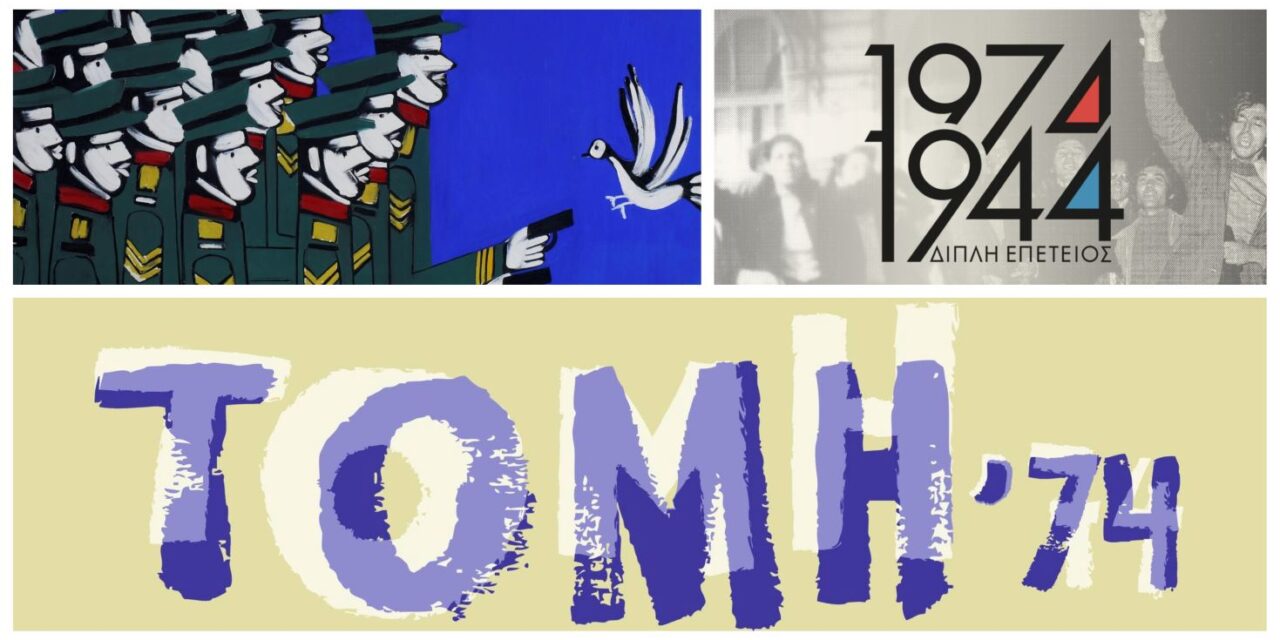In 2024, Greece commemorates the 50th anniversary of the fall of its military dictatorship (1967–1974) with a series of exhibitions reflecting on the nation’s journey from repression to democracy. These exhibitions explore the social, political, and cultural impacts of the dictatorship and its collapse, offering a window into this pivotal period in modern Greek history. Key exhibitions include “1974. From Dictatorship to Democracy” at the National Library of Greece, which chronicles the struggle against the regime and cultural and societal shift of the first years of the Metapolitefsi; “City of Athens 1974 & 1944 – Athens Celebrates its freedom” honoring two crucial milestonesons, the 50 years since the restoration of democracy in July 1974 and 80 years since the liberation of Athens from the Nazi occupation in October 1944 and finally, “Democracy,” an art exhibition at the National Gallery of Greece that explores artistic responses to the struggles against authoritarian rule and pursuit of democracy in 1960s-70s Greece, Spain, and Portugal.
National Library of Greece: “1974. From Dictatorship to Democracy”
The National Library of Greece (EBE), the General State Archives (GAK) and the Greek Broadcasting Corporation (ERT) are co-organizing an exhibition in celebration of the 50-year anniversary of the Metapolitefsi (post-dictatorship) period, entitled “1974. From Dictatorship to Democracy,” taking place from July 17 to December 31, 2024 at the National Library of Greece.
The exhibition presents unique archival evidence and rich audio-visual material on the dictatorship as well as the anti-dictatorship struggle, outlining the major institutional changes of first year of the Metapolitefsi period, but also the grand scheme changes in the social and cultural landscape of the country, up to the first years of the 1980s.
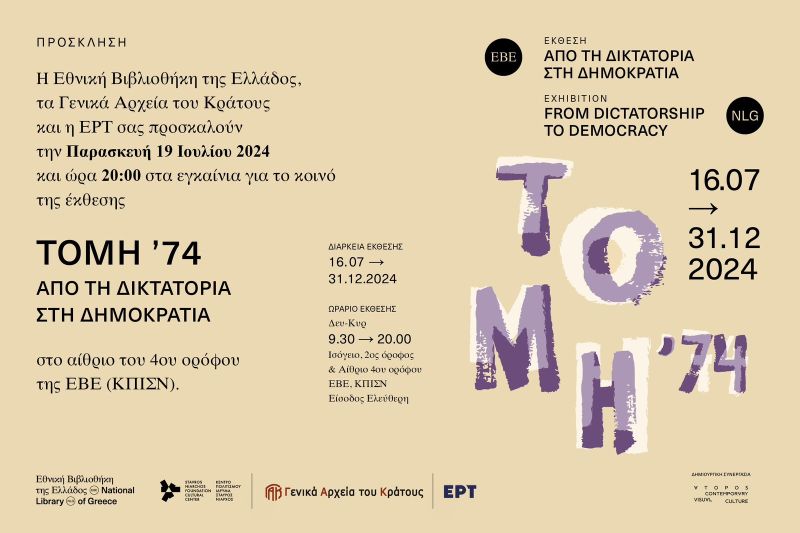
National Broadcaster ERT participates in the exhibition with material from its archive, including, among others, 100 photographs, 240 minutes of audio-visual material, censored documents from broadcasts and news, 20 vinyl records, etc. The National Library of Greece participates with material from its Collections, which mainly includes newspapers, magazines and books (over three hundred items in total). The exhibition is accompanied by a 288-page color catalogue, which is a publication of the National Library of Greece, edited by Stavros Zoumboulakis.
The artistic curation of the exhibition has been undertaken by Vassilis Zidianakis and ATOPOS, who invited the visual artist Alexis Fidetzis to present the installation “Phoenix Canariensis” on the ground floor of the National Library, posing the question: How does one present the continuity of archives through the plastic language of visual arts?
As the president of the National Library of Greece, Stavros Zoumboulakis notes: “Let us repeat the undeniable: the unprecedented, in Greek history, period of untroubled democratic life spanning half a century, was entrenched in those first few months of the Metapolitefsi. The Metapolitefsi is not merely the restoration of a pre-dictatorship Republic, but also the transition to a new period of a full democratic life.
We all know its three most critical achievements: the army’s return to the barracks, the end of the Monarchy, and the abolishment of Emergency Law 509. It was all carried out swiftly and dutifully by the first post-dictatorship national unity government and the first Prime Minister, Konstantinos Karamanlis, who undoubtedly played a pivotal role, as well as by dint of the forceful demand of mass democratic movements.


But no one can appreciate the significance of the Metapolitefsi without knowing about the dictatorship, its violence and its vulgarity. We want our exhibition to be one of memory and education, aiming to convey to its visitors, and especially to school pupils, both the horror of the Dictatorship and, most importantly, the belief that the Metapolitefsi of 1974 is a major political achievement. In a country with such high rates of self-pity, let us hold that fact in mind with a certain amount of pride.
In the purely political and institutional field, the Metapolitefsi lasted a few months, until the end of the year or, at the extreme, until the passage of the new Constitution in June 1975. But beyond that purely political and institutional Metapolitefsi, there is also a social and, even more so, cultural Metapolitefsi, whose limits cannot ever be strictly defined. What is for certain is that the wind of political change began to blow strong in the final years of the dictatorship, as early as 1970-71, with that unprecedented publishing boom, but was brutally interrupted by the junta of Ioannidis that seized power on 25 November 1973. In the summer of 1974, the country’s intellectual world picks up the severed thread once again and extends it, dynamically and with optimism. In the field of cultural Metapolitefsi, the exhibits of our exhibition stretch as far as the early 1980s.”
The President of the General Archives of the State, Dimitris Sotiropoulos commented that this exhibition brings together individual memory and the historiographic record. The exhibition, which spans the three floors of the EBE at the SNFCC, will run until 31 December 2024. Admission is free and the public can visit the exhibition every day of the week from 09:30-20:00.
City of Athens “1974 & 1944 | Athens Celebrates its freedom”: 50 years since the restoration of Democracy & 80 years since the Liberation of Athens
The year 2024 marks 50 years since the restoration of democracy in July 1974 and 80 years since the liberation of Athens from the Nazi occupation in October 1944. The City of Athens, in a spirit of unity and collaboration, is honoring these two crucial milestones for the country’s journey to freedom and democracy, as well as the struggles of the Greek citizens for national independence, by organizing a series of events called “1974 & 1944: Athens celebrates freedom”. The program, aiming to highlight the city’s vibrant historical memory and initiate a dialogue with our modern history is being designed and carried out by the City of Athens Culture, Sports and Youth Organization (OPANDA) and the Technopolis City of Athens, featuring a wide array of events and artistic and educational activities, which will take place until the end November.
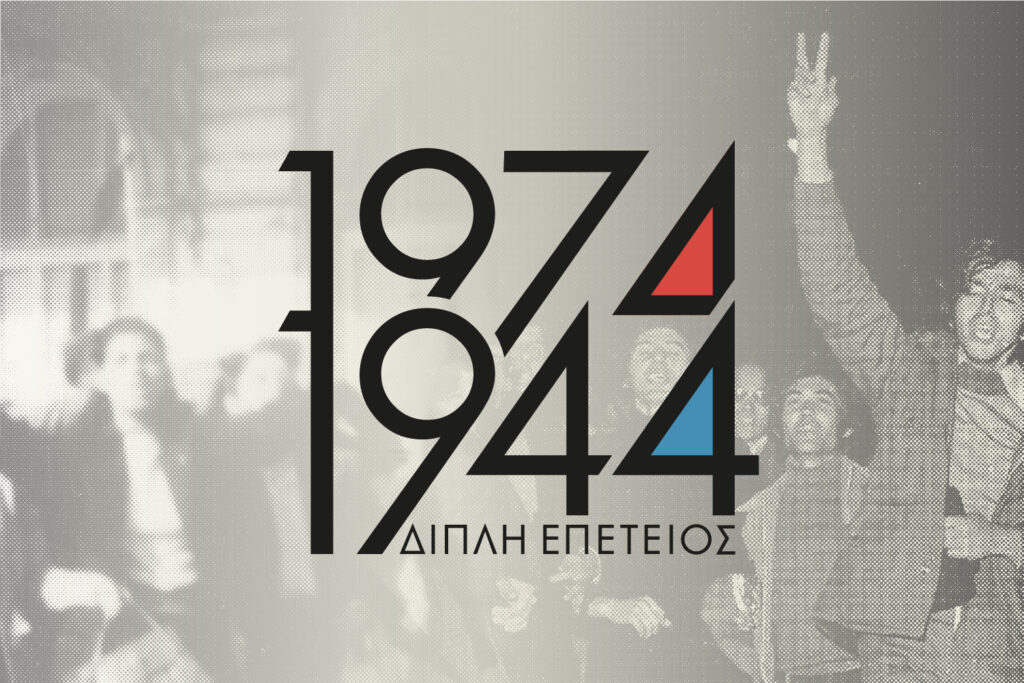
The major historical exhibition “1974 & 1944: Athens celebrates freedom”, which is the centerpiece of the City of Athens’ celebrations, is hosted at the OPANDA Arts Center, in Eleftherias Park. The venue, with its buildings of profound historical and architectural value, is part of the memorial site of the old junta Detention and Interrogation centers. From July 22 to October 28, the grand historical exhibition, a joint effort of the Technopolis City of Athens, the Contemporary Social History Archives (ASKI), and the General State Archives, commemorates this double anniversary.
Divided into two major sections, dedicated to the events of 1944 and 1974 respectively, the exhibition narrates a journey from darkness to light, from the extreme cruelty of the Nazi occupation to the frenzied celebration of the first days of freedom, and from the brutality of the junta to expectations born of the fall of the authoritarian regime. Through rare photographs, audio-visual material, documents, newspapers, posters, works of art, notices, personal items and rich archival material, the more than 500 items in the exhibition “1974 & 1944: Athens celebrates its freedom” the exhibition highlights the collective historical memory and the popular struggles for freedom and democracy, focusing on the feelings of hope and joy that these generate and the same enthusiasm that accompanied the Athenians both on the festive days of 1944 and 1974.
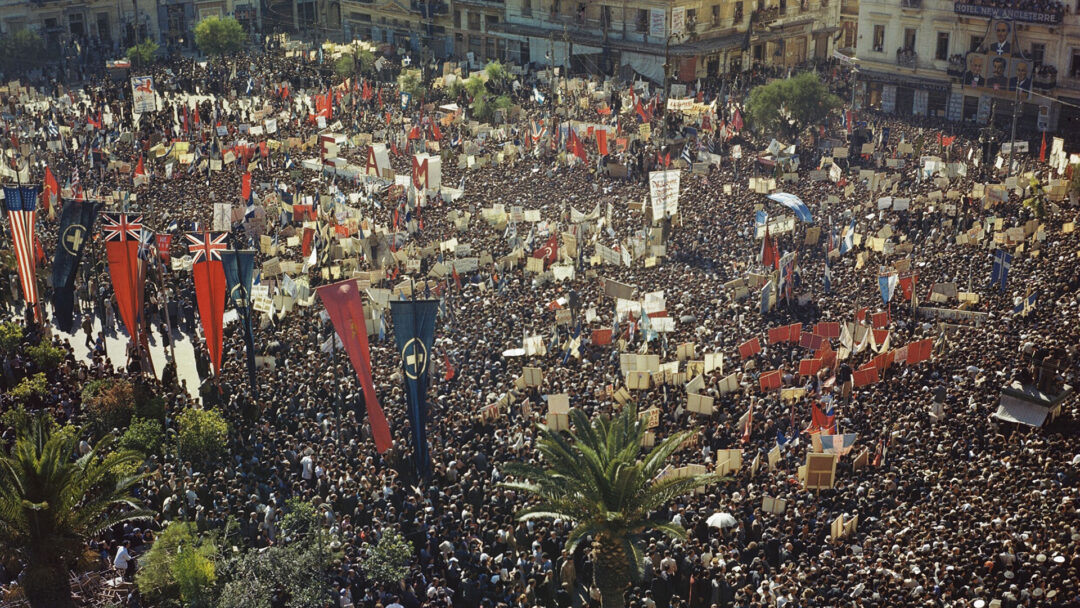
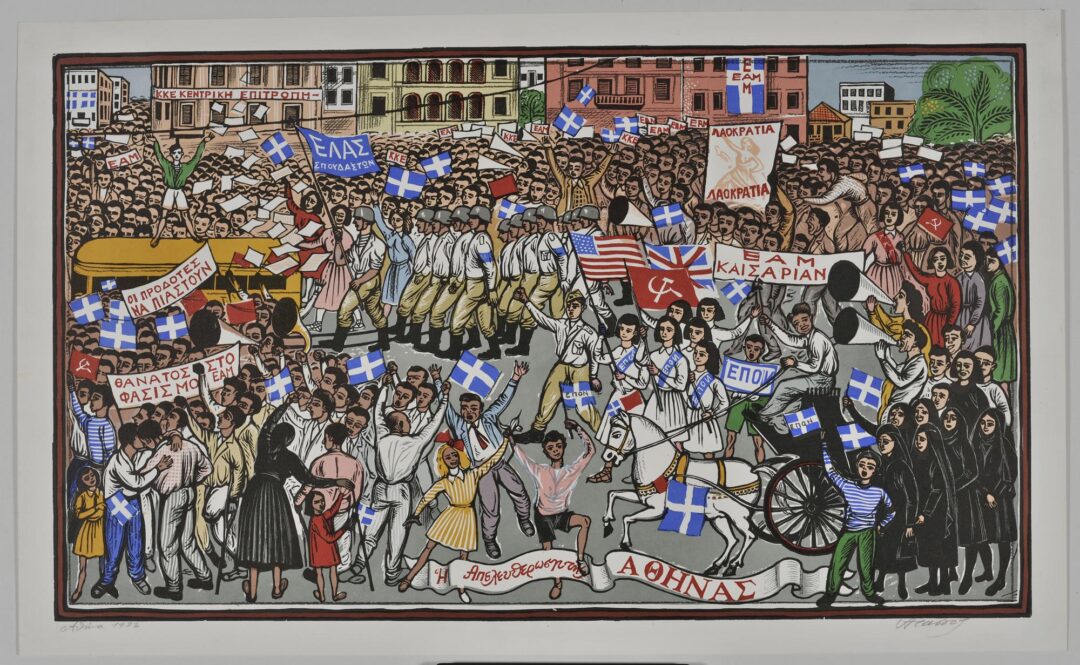
At the same time, the exhibition cannot but to unite joy with sorrow, redemption with pain, relief with agony, as the double holiday outbreak was weighed down by both the shadow of the Decemberists and the fear of civil war in 1944, as well as the Turkish invasion of Cyprus in 1974.
Visitors discover, among other things, evidence from the period of the great famine of 1941 in Athens, audiovisual material related to the arrest and torture practices of the junta, an installation with personal stories of three women of the Resistance who sacrificed themselves for the liberation, and also an installation dedicated to the 25 murdered activists of the Polytechnic Uprising.
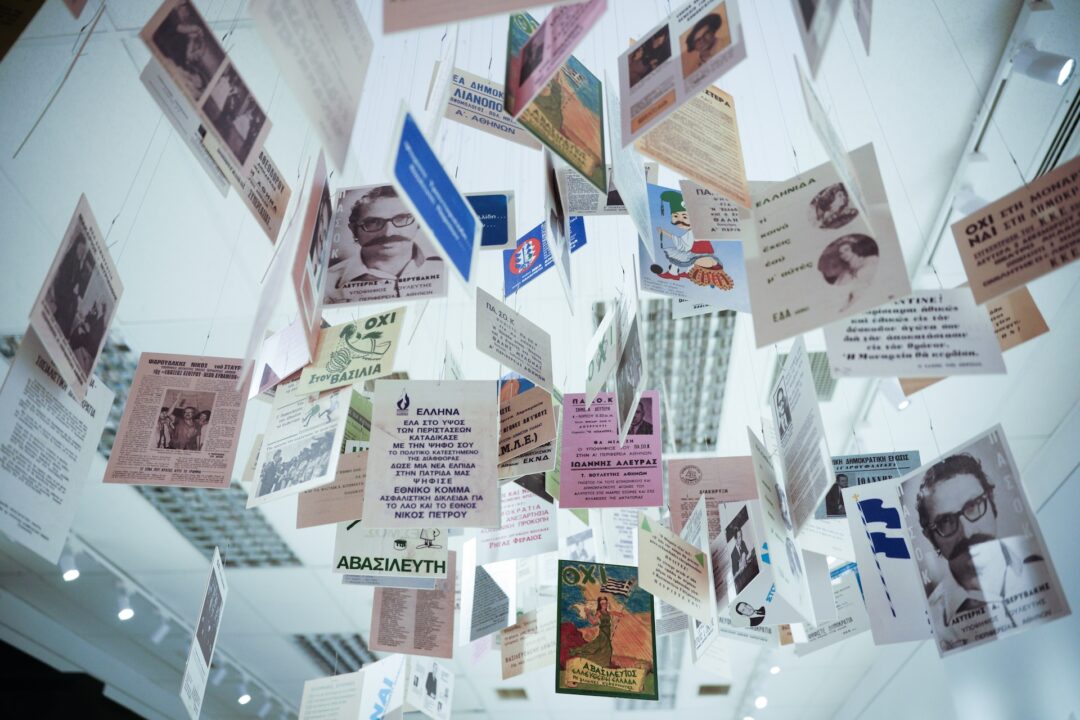
And on the other hand, in the center, unique impressions from the river of people that on the day of liberation in 1944 flooded the flag-decorated streets of the capital with songs and dances, flyers, banners and improvised posters full of festive slogans, celebratory front pages for the triumph of democracy, snapshots of hugs with those who returned from places of exile.
Some of the bitterest moments of Athens’ modern history join its happiest, in a unique exhibition that is a tribute to two different eras and two different worlds united by the same city, Athens, but the common demand of its inhabitants for democracy and freedom, the collective dream for a better life.

The exhibition, which ends on October 28 and has free entry, is surrounded by talks, discussions, screenings, special guided tours by the exhibition’s curators, educational programs, exhibitions, theatre, music, dance, theatrical and historical tours, activities for children and schools as well as an insert of contemporary dance and dance performances. See here for the detailed program of events.
National Gallery of Greece: “Democracy”
As nearly half the world goes to the polls in 2024 in a historic year of elections, the National Gallery of Greece in Athens unveils a timely exhibition on art, social change, and democracy. This is the first major exhibition to explore artistic responses to the struggles against authoritarian rule and pursuit of democracy in 1960s-70s Greece, Spain, and Portugal. It marks the 50th anniversary of the restoration of democracy in Greece.

Featuring 140 works by 55 artists, brought together in collaboration with the Museo Nacional Centro de Arte Reina Sofía – MNCARS, Museu d’Art Contemporani de Barcelona – MACBA, Centro de Arte Moderna Gulbenkian, Centro de Estudos Multidisciplinares Ernesto de Sousa and private collections from Greece and Portugal.
Running from 11 July 2024 to 2 February 2025, this is the first major international exhibition to examine the political role of art during the pivotal period in Southern European history as Greece, Portugal and Spain transitioned from authoritarian to democratic rule during the 1960s to 1970s.
The large-scale presentation brings together 140 masterpieces by 55 artists and artist groups, showcasing a diverse range of styles, perspectives, and practices. It explores how artists were inspired by and depicted the struggle against the era’s dictatorial regimes and the new cultural expressions and creative practices that evolved during the pursuit of civil liberties, including the rise of critical realism and abstract art, as well as the emergence of performance and conceptual art. The formation of artistic collectives, the art of protest in posters and prints, the politics of the body and the involvement of art in the public sphere all underscored the demand for democracy in the realm of the arts, providing a vibrant field for creative research and activity.
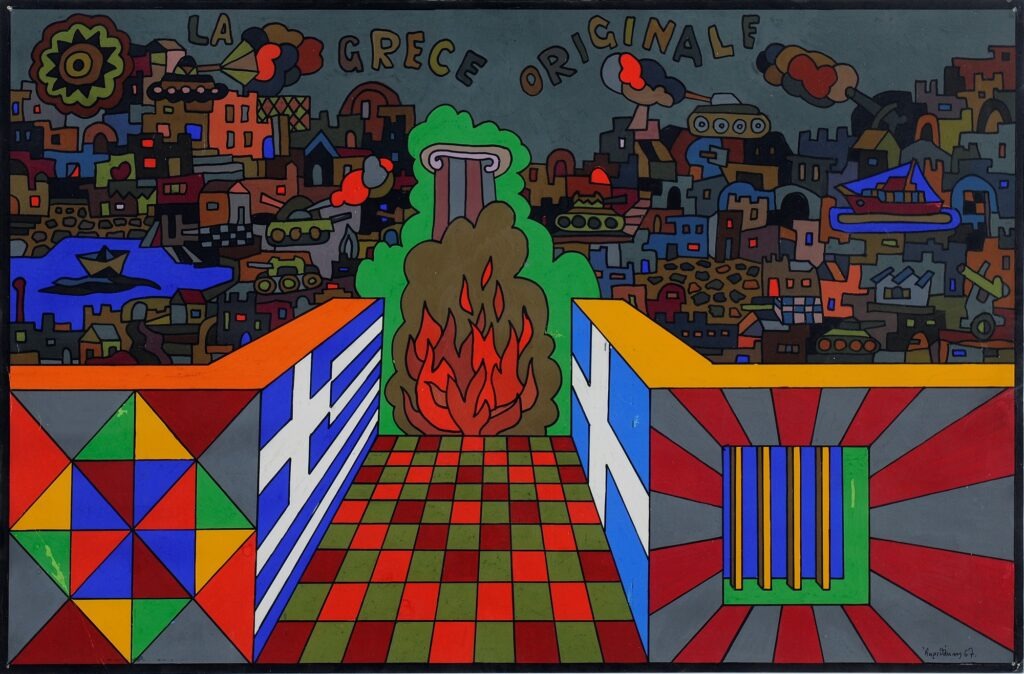
The National Gallery aims to reflect on the current socio-political state of the world and its resonance with the conflict and turmoil of 1960s and 1970s Southern Europe. Against the backdrop of a historic year of global elections and challenges to democratic values, the exhibition traces the shared cultural experiences, emotions, and trauma shaped by disruption, acts of protest, defiance, and resistance, that are just as relevant today as they were fifty years ago.
Syrago Tsiara, Curator and Director of National Gallery says “We proudly present our landmark exhibition on Democracy and Art in Greece, Spain, and Portugal, showcasing powerful artistic responses to repression and the fight for freedom. This exhibition prompts reflection on our historical experiences, achievements, and their impact on our collective identity and future. Amid rising extremist voices, declining voter turnout, and growing scepticism towards institutional credibility, it serves as a poignant reminder of the ongoing need to defend democracy. In these challenging times, museums and art play a vital role beyond solace, empowering profound engagement with imagery, ideas, and critical questions that shape our social interactions and coexistence.”

The exhibition explores themes of ‘Facing the Enemy’, ‘Resistance’, ‘Uprising’, and ‘Arousal’ through a range of artistic mediums, including sculpture, painting, engraving, posters, video, performance art, as well as theatre and literature and runs until 02.02.2025
Read also from Greek News Agenda
I.L.
TAGS: CITY OF ATHENS | DEMOCRACY | EXHIBITIONS | INTERNATIONAL EXHIBITIONS | METAPOLITEFSI | MODERN GREEK HISTORY

